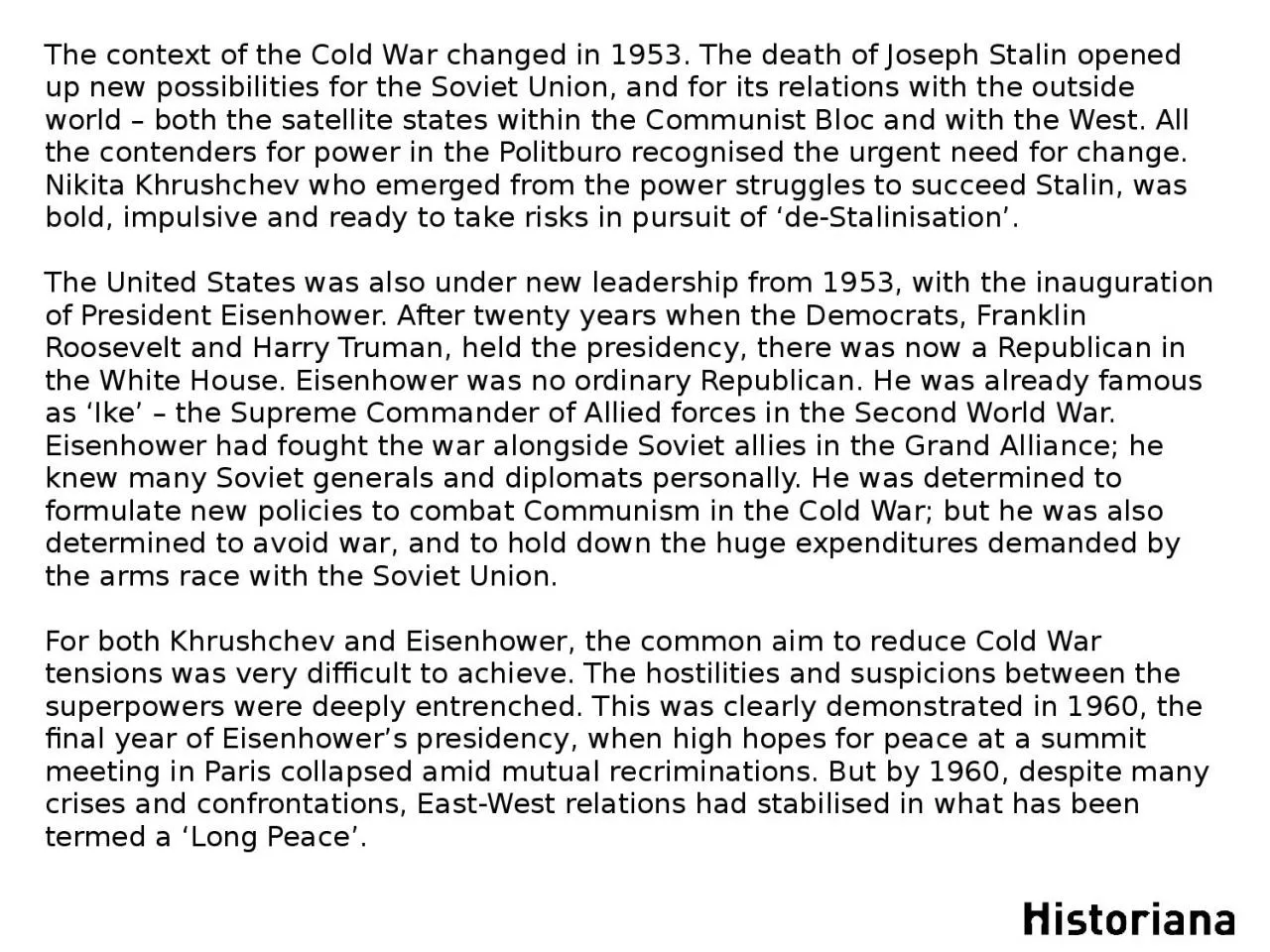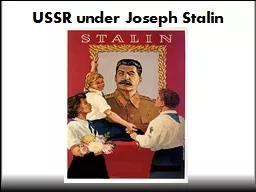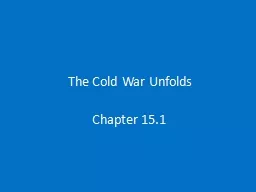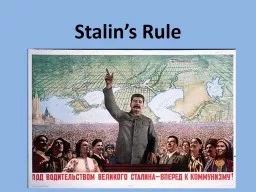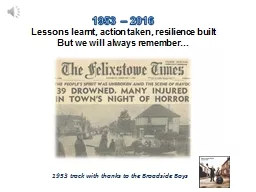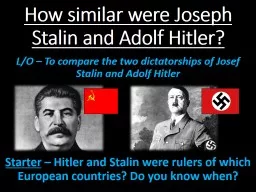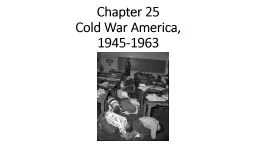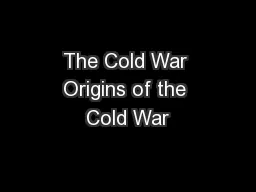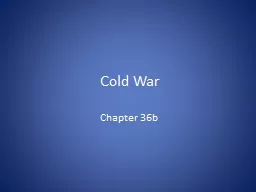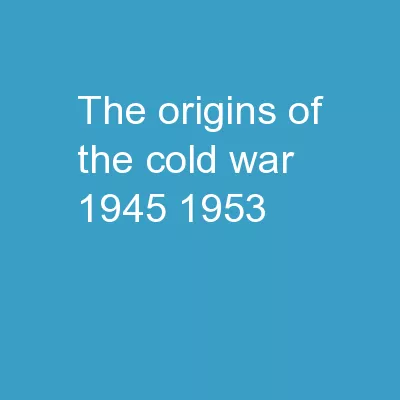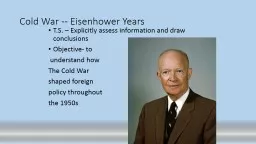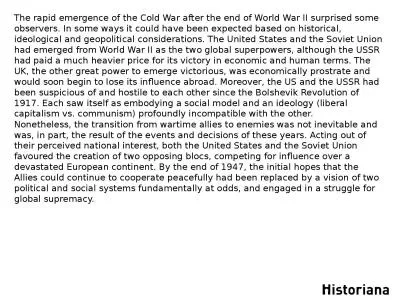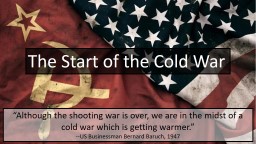PPT-The context of the Cold War changed in 1953. The death of Joseph Stalin opened up new
Author : carny | Published Date : 2023-09-19
The United States was also under new leadership from 1953 with the inauguration of President Eisenhower After twenty years when the Democrats Franklin Roosevelt
Presentation Embed Code
Download Presentation
Download Presentation The PPT/PDF document "The context of the Cold War changed in 1..." is the property of its rightful owner. Permission is granted to download and print the materials on this website for personal, non-commercial use only, and to display it on your personal computer provided you do not modify the materials and that you retain all copyright notices contained in the materials. By downloading content from our website, you accept the terms of this agreement.
The context of the Cold War changed in 1953. The death of Joseph Stalin opened up new: Transcript
The United States was also under new leadership from 1953 with the inauguration of President Eisenhower After twenty years when the Democrats Franklin Roosevelt and Harry Truman held the presidency there was now a Republican in the White House Eisenhower was no ordinary Republican He was already famous as Ike the Supreme Commander of Allied forces in the Second World War Eisenhower had fought the war alongside Soviet allies in the Grand Alliance he knew many Soviet generals and diplomats personally He was determined to formulate new policies to combat Communism in the Cold War but he was also determined to avoid war and to hold down the huge expenditures demanded by the arms race with the Soviet Union. Learning Objectives:. Must identify traits of Stalin. Should complete a timeline of his life. Could link events in Russia to his personality. Starter – making inferences:. Look at the pictures on your hand out.. War Communism . (Lenin). . . what. When. . : 1918 -1921. What. : Industry was nationalized, compulsory . labour. was introduced and private trade was suppressed. Why. : because of the desperate need to obtain food for the Red Army & the urban population. Chapter 15.1. Two Sides Face Off. Superpowers-US and USSR. NATO/Warsaw Pact. Iron Curtain-Winston Churchill describing the separation of Western and Eastern Europe. Berlin Wall. Eastern Europe resists USSR. Stalin Takes Power. When Lenin died in 1924, Joseph Stalin took power. He led the USSR through World War II and died in 1953. . By 1928, established himself as absolute dictator.. Totalitarian State. 2016. Lessons . learnt, action taken, resilience built. But we will always remember…. 1953 track with thanks to the Broadside Boys. “I was trapped in my home with my two children”. The Red Cross getting food parcels ready for those in need. L/O – To compare the two dictatorships of Josef Stalin and Adolf Hitler. Starter. – Hitler and Stalin were rulers of which European countries? Do you know when?. Investigating Dictatorships. During the first half of the 20. 1945-1963. Containment in a Divided World. The Cold War began at the close of WW2 in 1945 and ended in 1991.. The Cold War in Europe, 1945-1946. Yalta. Yalta Conference the “Big Three” met to reconcile . Period after WWII is referred to as the Cold War. : the tense relationship between capitalism (mainly the USA) and communism (Soviet Union). Postwar (after WWII) discussions were . postponed as long as possible. Why a cold war?. Setting the stage: During and After WWII . The U.S. and Soviet Union were . allies. during WWII. Both counties . spied. on each other during WWII . Both wanted to share as little as possible in the victory over the . By end of WWII, alliance between G.B., U.S., and U.S.S.R. disintegrating. Cold war = competition for global influence between democracy/capitalism and communism. Led to: alliances (-> “iron curtain”), client states, arms race, diplomatic . Revision for HSC 2014. The 1945 Conferences. Yalta Conference. In February 1945 Winston Churchill, Roosevelt and Stalin met at the Yalta Conference. At this conference it was decided that Germany would be divided into four allied sectors after the war; that the Soviet Union would join the war against Japan; free elections would be held throughout Eastern Europe and the Lublin Committee, provisional Polish government, would no longer consist of just Communists. However, the Soviet Union did not adhere to these terms and instead; Stalin began to install communist governments in other Eastern European countries. . T.S. – Explicitly assess information and draw conclusions. Objective- to . understand how . The Cold War . shaped foreign. policy throughout . the 1950s. Cold War under Eisenhower. Brinkmanship. : taking the country to the brink of war to avoid war (Sect. of State Dulles). Nonetheless, the transition from wartime allies to enemies was not inevitable and was, in part, the result of the events and decisions of these years. Acting out of their perceived national interest, both the United States and the Soviet Union favoured the creation of two opposing blocs, competing for influence over a devastated European continent. By the end of 1947, the initial hopes that the Allies could continue to cooperate peacefully had been replaced by a vision of two political and social systems fundamentally at odds, and engaged in a struggle for global supremacy.. --US Businessman Bernard Baruch, 1947. The Start of the Cold War. As One War Ends…A New One Begins. By the end of 1945, with the Second World War over, tensions between the Allies (United States and the Soviet Union) were already apparent. The situation only grew more tense the follow year. In 1946, the following occurred:.
Download Document
Here is the link to download the presentation.
"The context of the Cold War changed in 1953. The death of Joseph Stalin opened up new"The content belongs to its owner. You may download and print it for personal use, without modification, and keep all copyright notices. By downloading, you agree to these terms.
Related Documents

